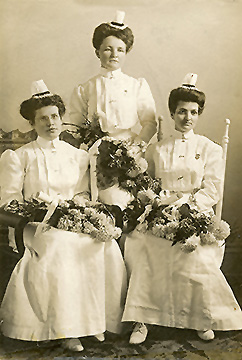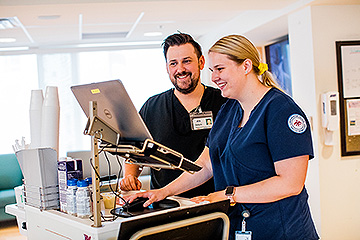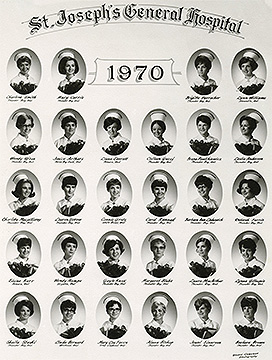News
Celebrating Nursing Week
As we celebrate Nursing Week May 6-12, we look at the past, present and future of nursing profession at St. Joseph's Care Group.
Date: 2019-05-07
“It’s not just a job,” says Doris Rossi, a 1965 graduate of St. Joseph’s School of Nursing, who went on to teach nursing students in Thunder Bay for 32 years. “Nursing is about the quality of care, and about compassion and concern. It’s direct and hands-on.”
While medical and technical innovation has changed many aspects of nursing in the 115 years since the School of Nursing was founded at St. Joseph’s Hospital, those core values of care, compassion and commitment remain at the forefront. Today, St. Joseph’s Care Group has more than 600 registered nurses, registered practical nurses and nurse practitioners, working in long-term care, rehabilitative care, palliative care and mental health and addictions.
As Director of Collaborative Practice and Chief Nursing Executive, Shelley McAllister works to put systems in place to ensure that there is quality health care across the organization. Part of that process involved becoming designated as a Best Practice Spotlight Organization in 2018, partnering with the Registered Nurses Association of Ontario (RNAO) to implement and evaluate RNAO Best Practice Guidelines. The goal: make a positive impact on client care through evidence-based practice.
There are more than 50 best practice guidelines, such as Falls Prevention and Preventing and Managing Violence in the Workplace, says McAllister. “Another example of a guideline we are currently working on implementing is called ‘Engaging Clients who Use Substances.’ Nursing identified that they needed more information and support to work with our clients who use substances. A working group completed a gap analysis, reviewed the recommendations within the guidelines and determined where we needed to focus our efforts. Currently, we’re looking at a process for identifying clients who use substances, and ensuring we have resources and processes in place to help our nurses to develop care plans that will help our clients. It’s very important to engage our nurses and get them involved in the quality improvement work.”
Another way that SJCG nurses take part in collaborative leadership is through the Nursing Quality Practice Council, with more than 25 nurses representing various parts of the organization. “They provide insight into nursing practice, policies, procedures, quality improvement - all aspects of delivering care. Their voices are extremely important,” says McAllister. “They are frontline nurses, and when we talk about the need for a new process, policy or procedure, they provide valuable input into how to make the change effective.”
Looking ahead, nursing at SJCG carries new challenges and opportunities. “What I love about nursing is the variety of paths that you can take in your career,” says Tracy Buckler, President and CEO of St. Joseph’ Care Group, who began her career as a Registered Nurse with St. Joseph’s Hospital when it was providing acute care services. “As technology advances, as health care changes, the practice of nursing evolves and adapts. I’ve often said that I have never had a boring day at work.” Buckler notes that St. Joseph’s Care Group works hard to develop talent, whether through the Nursing Preceptor Education Program for new nurses, collaboration with educational institutions, or supporting staff to further their education. “When you do what you love, and when you’re supported to learn and grow, it directly translates into the exceptional care that you give to clients.”
St. Joseph's Hospital School of Nursing: A Look Back
1904 - St. Joseph’s Training School, as St. Joseph’s Hospital School of Nursing was originally known, was established. The first class of six students lived in the hospital and graduated in 1907.
1910 - Nurses’ Alumnae was founded, with the aim of promoting unity and goodwill, and advancing the nursing profession.
1928 - Neelin home was purchased and converted into the first Nurses’ Residence.
1955 - New Nurses’ Residence and School of Nursing opened, with accommodations for 108 students as well as lecture rooms, laboratories, a gymnasium and auditorium, a library and lounges.
1968-1970 - Lakehead Regional School of Nursing opens, resulting in the phasing out of the individual hospital-based nursing schools. The last class from St. Joseph’s Hospital School of Nursing graduated in 1970. Over the 66 years of operation, 845 students graduated.
1970-2010 - The former Nurses’ Residence and School of Nursing building was used to house clinics and other associated services. In 1972, the Smith Alcohol and Drug Abuse Clinic (later renamed the Sister Margaret Smith Centre) relocated from the hospital to the former school. The new Sister Margaret Smith Centre opened on Lillie Street in 2009.
2012-present - In 2012 the building was razed and the land became the site for the East Wing Expansion of St. Joseph’s Hospital for the Mental Health Rehabilitation Program, which opened in 2018.
Historic Crest
Did you know that the original floor crest of St. Joseph’s Hospital School of Nursing has a new home and place of honour in the main entrance to St. Joseph’s Hospital? The crest was designed by a student, Dorothy Santucci (class of 1954) and created by Jerry Della Mattia. Prior to the demolition of the School of Nursing building, the 700 kg crest was painstakingly removed, stored and then inlaid with the new terrazzo at St. Joseph’s Hospital. It’s a welcoming symbol and lasting tribute to the history of St. Joseph’s Hospital School of Nursing.





